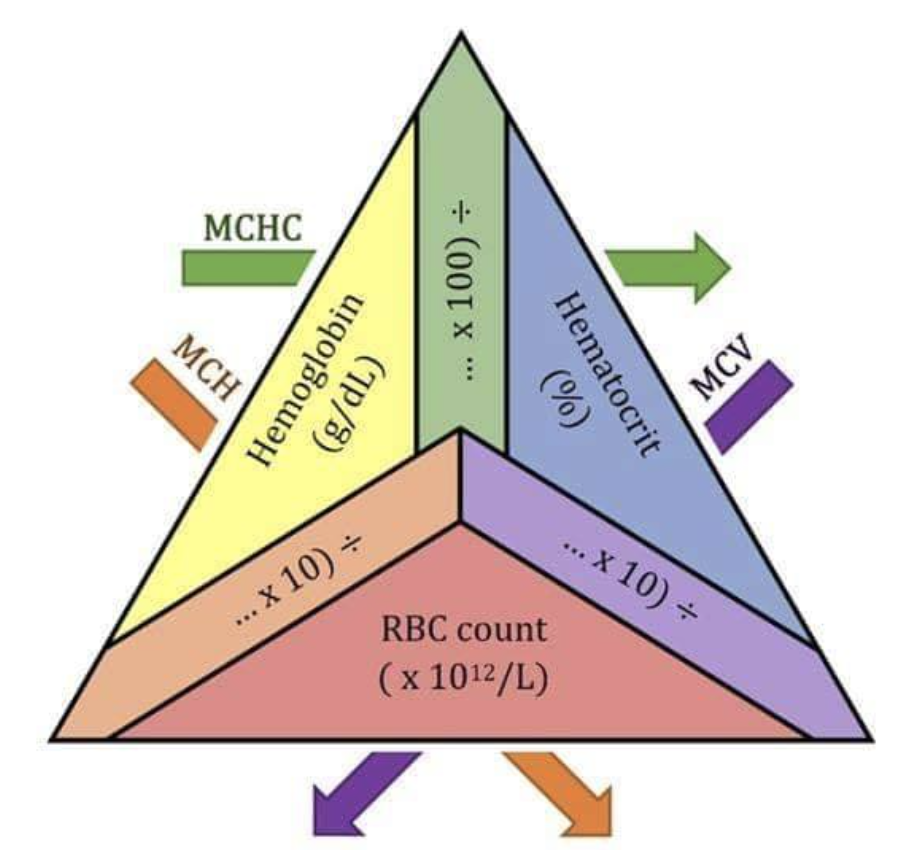Fundamental Hematology Principles & Hematopoiesis
1/65
There's no tags or description
Looks like no tags are added yet.
Name | Mastery | Learn | Test | Matching | Spaced |
|---|
No study sessions yet.
66 Terms
Whole Blood Includes…?
Erythrocytes, leukocytes, platelets, and plasma
Buffy Coat
Small white layer btn RBCs & plasma
Appears when specimen is centrifuged
Leukocytes and platelets
Plasma
Liquid portion of unclotted blood OR component produced when blood contains anticoagulant
Serum
fluid remaining after coagulation and a clot has formed
Plasma vs Serum
contains all coags factors vs lacking fibrinogen group coag proteins
Homeostasis
the process that maintains stable internal conditions in the body, including blood clotting and fluid balance.
Normal Osmotic Concentration
Termed Isotonic, meaning the osmotic pressure is balanced with that of the cells, preventing net movement of water.
Hypotonic Solution
↑ H2O, ↓ Solute conc.
Cells swell → lyse
Hypertonic Solution
↓ H2O, ↑ Solute conc.
Cells crenate
pH reference range: venous vs. arterial blood
venous: 7.36-7.41
arterial: 7.38-7.44
Body Temp Normal Range
37°C (97-99°F)
MCV (mean corpuscular volume) range, definition, and importance
80-100 fL
avg. vol. of RBC
↑ = megaloblastic anemia, hemolytic anemia, liver disease, norm newborn
↓ = iron defic. anemia, thalessemia, sideroblastic aneia, lead poisoning
MCH (mean corpuscular HgB) range, definition, and importance
26-34 pg
avg. weight of HgB in RBC
↑ = macroytic anemia
↓ = microcytic, hyperchromic anemia
MCHC (mean corpuscular HgB conc.) range, definition, and importance
32-37 g/dL
avg. conc of HgB in RBC
↑ = error or presence of spherocytes
↓ = hypochromic RBCs → iron defic. and thalessemia
MCH (pg) formula
Hgb (g/dL) x 10 / RBC count ( x 10^12/L)
MCV (fL) formula
HCT (%) x 10 / RBC count (x 10^12/L)
MCHC (g/dL) formula
Hgb (g/dL) x 100 / Hct (%)
RBC indicies triangle

Hgb (Hemoglobin) Reference Range
Males: 13.5-17.5 g/dL
Females: 12.0-16.0 g/dL
Platelets Referene Range
150 - 450 × 10^9/L (150,000-450,000/uL)
MPV (mean platelet volume)
6.8 - 10.2 fL
*Note: MPV is analagous to MCV for RBCs
Relative vs Absolute Count
Proportion of a cell type in WBC count % vs. actual cells per blood volume #.
Relative Lymphocytosis
inc. in % of lymphocytes, associated w/ neutropenia
Absolute Lymphocytosis
inc. in # of lymphocytes
Relative vs Absolute polycythemia
increase in RBCs, distinguishing between % and actual # of cells.
Nonvital (dead cell) polychrome (Romanowsky)
Most common: Wright stain
Contains Methylene blue: basic dye that stains acidic (DNA and RNA) blue
Contains Eosin: acidic dye that stains basic (Hgb and eosinophilic cytoplasmic granules) red-orange
Methanol Fixative
Phosphate Buffer: 6.4-6.8
Causes of RBCs too red and WBC nuclei poorly stains
< 6.4 pH, excess buffer, dec. staining time, inc. washing time, thin, expired stains
RBCs and WBC nuclei poorly stained
> pH 6.8, too little buffer, inc. staining time, poor washing, thick smear, inc. protein, heparinized blood sample
Nonvital Monochrome Stain
Ex: Prussian blue stain, used to identify iron granules
Supravital Monochrome Stain
New methylene blue: stains RNA in reticulocytes
Measure level of erythropoiesis
Neutral red w/ brilliant cresyl green: visualize heinz bodies
shows G6PD deficiency, unstable HgB
Hematopoesis
Production and differentiation of blood cells in the bone marrow.
Reticuloendothelial System (RES)
Blood cell production, maturation, and death occur in the organs
includes: BM, spleen, liver, thymus, lymph nodes
RES functions in…?
Hematopoiesis, phagocytosis, and immune defense
Intrauterine Hematopoiesis includes three phases
Mesoblastic (yolk sac):
primitive nucleated erythroblast → primitive nucleated erythroblast → Hgb: portland, Gower I-II
Hepatic (liver) phase:
RBCs production → Hgb F
Myeloid/Medullary:
BM produces granulocytes → HgbF (HgbA after 6 months)
Red marrow → yellow marrow
Bone Marrow Cellularity
Ratio of marrow cells to fat (hematopoetic cells)
Normocellular: 30-70%
Hypercellular/Hyperplastic: >70%
Hypocellular/Hypoplastic: <30%
Aplastic: Little to none
Pluripotential Stem Cells
develop into committed progenitor cells (lymphoid or myeloid)
Lymphoid Cells
B or T lymphocytes
Myeloid cells
CFU-GEMM → differentiates into different committed progenitor cells → mature blood cells
Primary vs. Secondary Lymphoid Tissue
Antigen-INDEPENDENT vs. Antigen-DEPENDENT
Primary Lymphoid Tissue
BM: site of pre-B cell differentiation
Thymus: site of T cell differentiation
Secondary Lymphoid Tissue
B and T lymphs enter blood
Includes lymph nodes, spleen, gut-associated (peyer’s patch)
Phagocytes vs Immunocytes
Granulocytes, monocytes vs. lymphocytes, plasma cells, and monocytes
WBC ref. range
4.0 - 11.0 x 10^9 cells/L (10³ /uL)
Granulocyte
Neutrophils, PMNs, Seg Eos, & Basos
Neutrophils
1st to Phagocytize, destroy bacteria
Monocytes
differentiate into macrophages, phagocytize foreign bodies
T Lymphocytes
provide cellular immunity, produce cytokines/interleukins
B Lymphocytes
develop into plasma cells, produce antibodies, needed for humoral immunity
NK cells
natural killer cells, large granular lymphocytes
Eosinophils
mediate allergic response, caused by basophil degranulation and combat parasitic infections by releasing cytotoxic granules.
Basophils
mediate intermediate hypersensitivity rxns (type I, anaphylactic)
Lymphoid, Pan T Cells CD Marker
CD2, CD3
Helper/Inducer T Cells CD Marker
CD4
Suppressor/Cytotoxic T Cells CD Marker
CD8
Pan Myeloid CD Marker
CD13
Monocytes CD Markers
CD11c, CD14
Lymphoid, pan B cells CD Marker
CD19, CD20
Pan Myeloid CD Marker
CD33
Stem cell marker (lymphoid and myeloid precursor) CD Marker
CD34
NK Cells CD Marker
CD16, CD56
Medullar hematopoiesis
Within BM, 5th month of gestation
Extramedullary hematopoiesis
Outside BM
occurs when BM cannot meet body requirements
occurs mainly in the liver and spleen, hepatomegaly and/or splenomegaly
Nucleus
Chromatin: composed of DNA and proteins
Nucleoli: RNA
Cytoplasm
Golgi complex
Lysosomes
Ribosomes
Mitochondria
Endoplasmic reticulum
General Cell IMMATURE CELLS Maturation Characteristics
Cell is large
Nucleoli Present
Chromatin Fine and Delicate
Nucleus Round
Cytoplasm dark blue (rich in RNA)
High N:C ratio
General Cell MATURE CELLS Maturation Characteristics
Cell is smaller
Nucleoli absent
Chromatin coarse and clumped
Nucleus round, lobulated, or segmented
Cytoplasm pale blue (less RNA)
Low N:C ratio